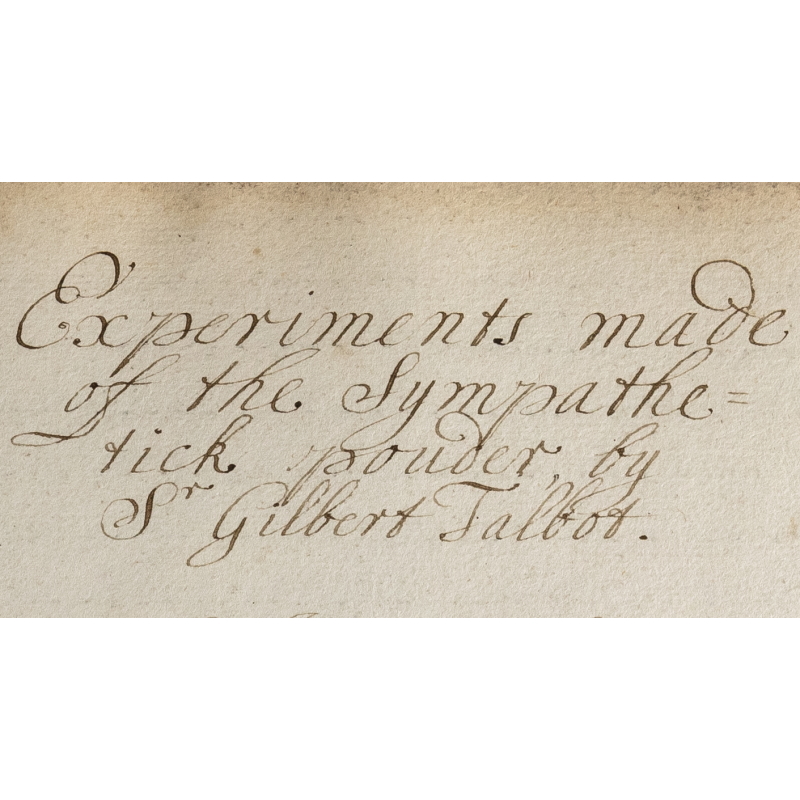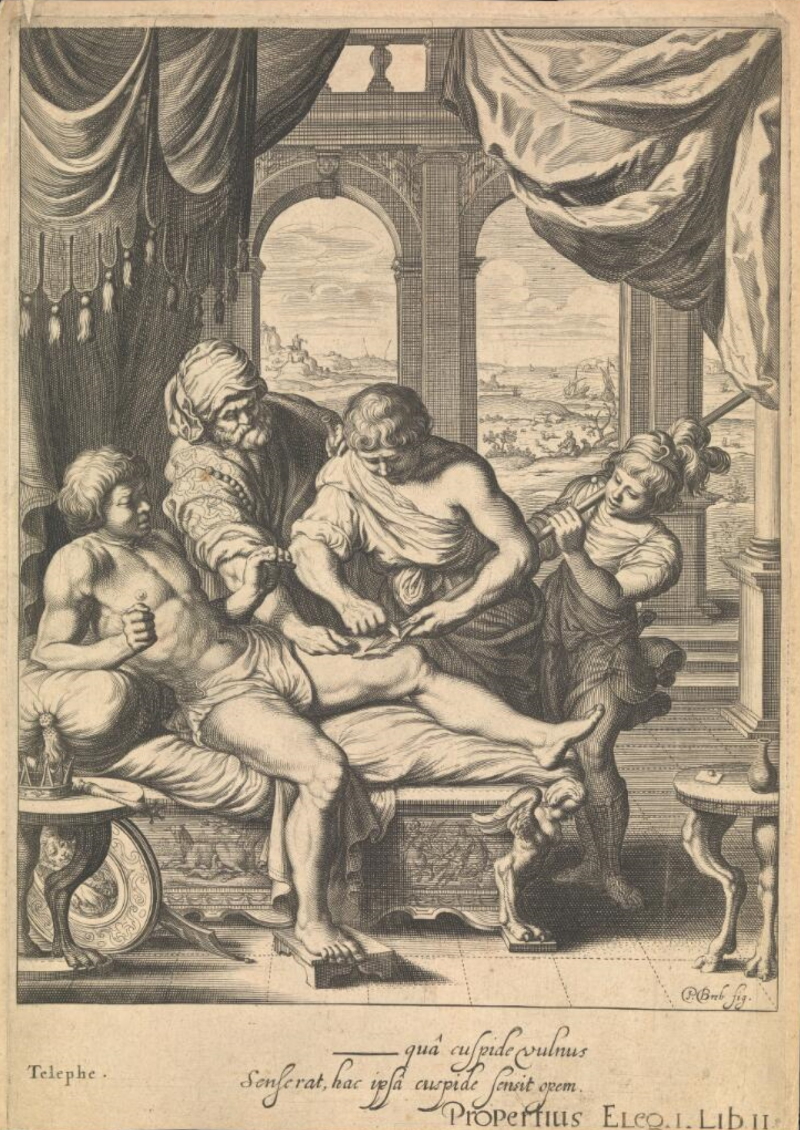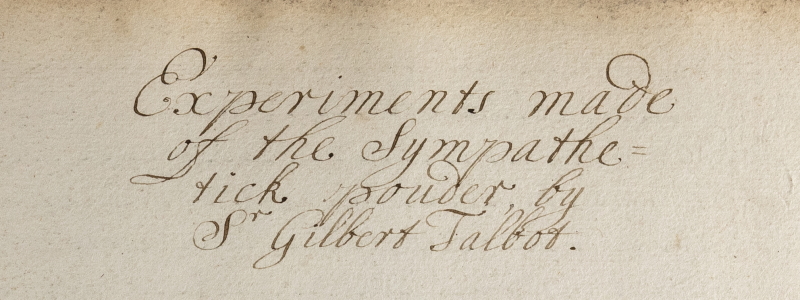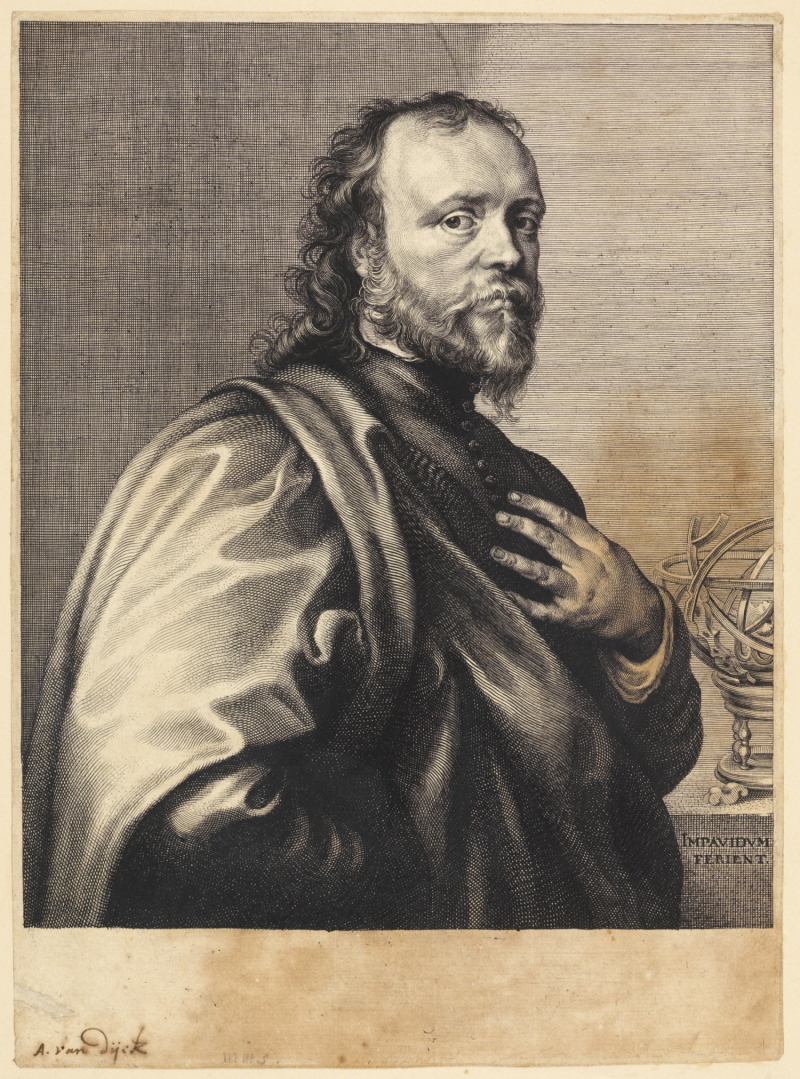Isabel Lauterjung finds some curious references to weapon salves and the cure of wounds at a distance in the archives of the Royal Society.

As an archive cataloguer, I spend half my time working on entries on our catalogue of past Fellows. I research, amend, and add to them to make the catalogue more accessible and informative.
Whenever I tackle a Fellow’s entry, I have my checklist to work through: standard biographical details, career moves, and where they fit into their cultural and societal context, for example. As part of this, it’s also vital to look through our collections for mentions of a Fellow to establish a more detailed insight into their contribution to the Society, in particular during its early days.
Recently, one of these searches led me to read about a proposition made at an ordinary meeting by Sir Gilbert Talbot ‘to torment a man presently with the sympatheticall pouder’, which naturally sent me down a rabbit hole (as working with these collections regularly does). This powder did seem to enjoy some popularity amongst other Fellows: Sir Robert Moray and William Hammond also contributed their creations.
Sympathetic cures were a form of healing that divided the world of natural philosophers in the seventeenth century. They were intended to heal an injury without ever touching it – ‘the cure of wounds at a distance’, as recorded on Robert Boyle’s to-do list – via the power of sympathy. There were two general types of sympathetic cure: the first was a weapon salve, applied to a weapon that had caused a wound rather than the wound itself. Weapon salves were considered to be more ‘exotic’ as they contained more unconventional ingredients, such as skull moss. The second type of sympathetic cure was a powder that was more ‘straightforward’, consisting of (usually green) vitriol. The powder was dissolved in water, then a bloody dressing from a wound was dipped in the solution. A sympathetic connection between the blood from the wound and the wound itself would then supposedly result in a cure.
Some of the earliest variations of such ideas go back to ancient mythology. In narratives about the Trojan War, Telephus, son of Heracles, was injured by Achilles’s spear and could subsequently only be healed by applying rust from that spear to the wound. Later in the seventeenth century, the idea was even used to try and solve the longitude problem. The idea was to take an injured dog on a sea voyage, while keeping in London (say) a bloody bandage that had been used on its wounds. At a time agreed upon before departure, the bandage was dipped into powder solution and the dog would then show a reaction by barking. Sailors on board the ship would then know the precise hour in London, and could complete accurately timed observations.
 Telephus (son of Hercules) cured of a potentially fatal wound with some rust from Achilles's spear. Engraving after P. Brebiette; Public Domain
Telephus (son of Hercules) cured of a potentially fatal wound with some rust from Achilles's spear. Engraving after P. Brebiette; Public Domain
Sir Gilbert Talbot is prominent in any searches for sympathetic powder and seems to have been known amongst his peers for developing one. Shortly after his admission to the Society in May 1661, he promised to present what he knew on sympathetic cures, and promptly delivered ten examples of successful administrations.
 ‘Experiments made of the Sympathetick pouder, by Sir Gilbert Talbot’ (RBO/1/11 p.1)
‘Experiments made of the Sympathetick pouder, by Sir Gilbert Talbot’ (RBO/1/11 p.1)
Particularly prominent in this retelling of somewhat fantastical stories are patients who were wounded in battles and sieges. Talbot even seems to have ‘cured’ himself after being injured during the 1645 Siege of Tiverton, where he was commander. While he was able to heal wounds sustained from wooden splinters, a large part of his body suffered from extensive bruising for weeks after the procedure.
Even before Talbot, Sir Kenelm Digby, later to become a Fellow of the Royal Society, wrote extensively on such treatments. In one of his better-known cases, Digby, credited with introducing and popularising the weapon salve in England, demonstrated the supposed effects of the powder to the Duke of Buckingham, by ‘curing’ a gentleman named James Howell who had suffered a severe puncture wound to his hand. Digby laid a bloody dressing taken from Howell’s wound into his vitriol water mixture, and reported that Howell experienced renewed relief in his hand whenever more powder was added to the mixture or the water was changed. Digby’s use of such cures, and his extensive 1658 treatise (A Late Discourse…touching the cure of wounds by the powder of sympathy), have been studied in depth, partly to investigate how an otherwise well-respected natural philosopher could be a proponent of a form of medicine largely considered to be superstition or simply implausible.
 Engraving of Sir Kenelm Digby (RS.17107)
Engraving of Sir Kenelm Digby (RS.17107)
By the late seventeenth century, the notion of sympathetic medicine was regarded with increasing scepticism and was considered to tarnish a ‘respectable’ natural philosopher’s reputation in his field. Antoni van Leeuwenhoek wrote to the Royal Society in 1697 and recounted a meeting with someone who could reportedly cure people at a distance, in particular through a patient’s urine, leading Leeuwenhoek to conclude that ‘all what he has told me concerning his working […] find no belief in me.’
Nowadays, it may seem outlandish that people, in particular eminent members of a learned society, would propagate an idea of healing at a distance and curing the weapon rather than the injury it caused. As easy as it is to pass judgement with today’s knowledge and scientific advancements in mind, some scholars have pointed out that some of the documented ‘successes’ of these cures could be linked not to the power of sympathy but to the power of reduced infection risk. After all, these procedures would have required the wounds to be kept clean and meant that the patient wasn’t exposed to other contemporary nostrums that might have hindered the healing process.
Nevertheless, these insights into the more unconventional-seeming experiments and observations that were presented to the Royal Society remain a fascinating insight into medical and philosophical thought of the time, and have made working with these collections particularly interesting.







